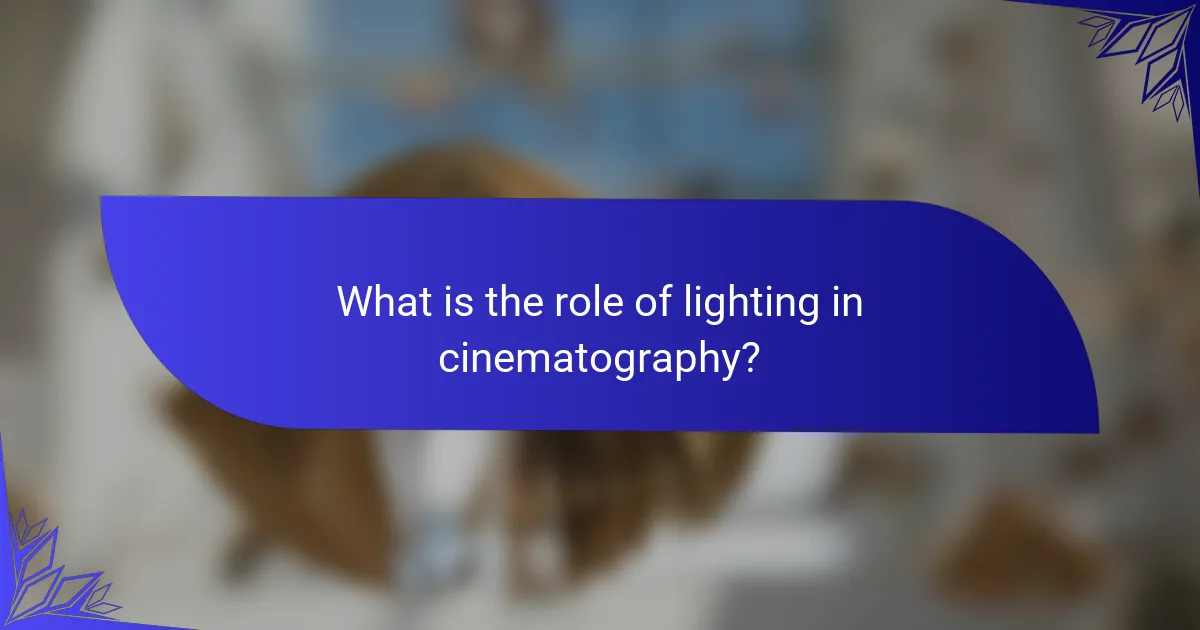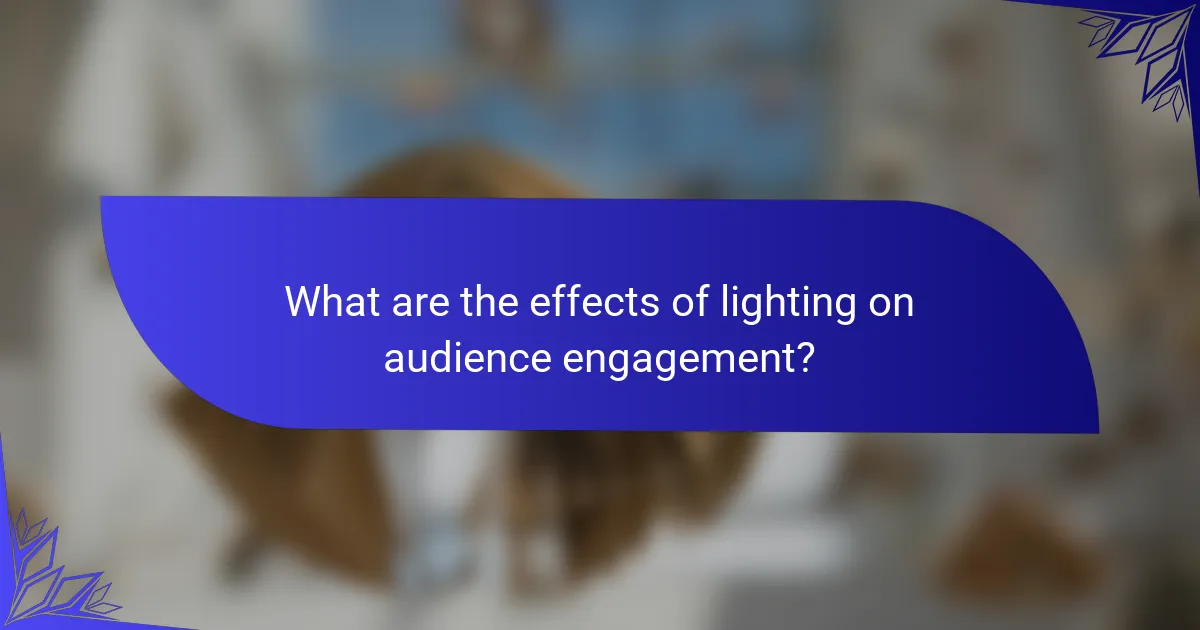Lighting in cinematography is a critical component that establishes the visual tone and mood of scenes, enhancing storytelling by directing viewer attention to key elements. Various lighting techniques, such as high-key and low-key lighting, create distinct emotional effects and influence the perception of time and space. Effective lighting design not only engages audiences by evoking specific emotions but also maintains viewer attention, as supported by research findings. Practical tips for cinematographers include using three-point lighting, considering color temperature, utilizing natural light, controlling shadows, and employing diffusers and reflectors to achieve optimal results. Mastery of lighting techniques is essential for creating compelling visual narratives in film.

What is the role of lighting in cinematography?
Lighting in cinematography establishes the visual tone and mood of a scene. It enhances storytelling by highlighting key elements and guiding viewer attention. Different lighting techniques create various effects, such as shadows for suspense or soft light for romance. Lighting also influences the perception of time and space within a shot. For example, high-key lighting suggests a cheerful atmosphere, while low-key lighting conveys drama. The placement and intensity of lights can alter character portrayal and emotional impact. Mastering lighting is essential for cinematographers to create a compelling visual narrative.
How does lighting influence the visual storytelling in film?
Lighting significantly influences visual storytelling in film by shaping mood, emphasizing themes, and guiding audience attention. It sets the emotional tone, with bright lighting often conveying happiness and darkness suggesting tension or fear. Different lighting techniques, such as high-key and low-key lighting, create distinct atmospheres. High-key lighting reduces shadows and produces a cheerful ambiance. Conversely, low-key lighting introduces shadows and creates a sense of mystery or danger.
Moreover, lighting can highlight specific characters or objects, directing the viewer’s focus. For instance, a spotlight can isolate a protagonist, making them the center of attention. Additionally, color temperature in lighting can evoke different feelings; warm tones often feel inviting, while cool tones can feel unsettling. Historical examples, such as the use of chiaroscuro in film noir, illustrate how lighting can enhance storytelling by creating dramatic contrasts. Overall, effective lighting is crucial for conveying narrative and emotional depth in film.
What are the fundamental principles of lighting in cinematography?
The fundamental principles of lighting in cinematography include three key elements: intensity, direction, and color. Intensity refers to the brightness of the light source used. It affects visibility and mood in a scene. Direction describes the angle from which light hits the subject. This can create shadows and highlights, influencing depth and dimension. Color involves the hue of the light, which can evoke different emotions. For instance, warm tones can create a sense of comfort, while cool tones might convey tension. Together, these principles shape the visual storytelling in film. They guide the audience’s emotional response and enhance narrative impact.
How does lighting affect the audience’s perception of characters and scenes?
Lighting significantly influences the audience’s perception of characters and scenes. It shapes the mood, highlights emotions, and directs focus. Bright lighting often conveys a sense of happiness or clarity. Conversely, dim lighting can evoke feelings of tension or mystery. High contrast lighting creates dramatic effects, emphasizing conflict or danger. Soft lighting tends to flatter characters and create intimacy. The color of lighting also plays a crucial role; warm tones can suggest comfort, while cool tones may indicate sadness. Studies show that lighting can alter viewers’ emotional responses and interpretations of a scene. For example, research by K. W. Smith in “The Psychological Effects of Lighting in Film” demonstrates that lighting choices directly affect audience engagement and emotional reactions.
What types of lighting techniques are commonly used in cinematography?
Common lighting techniques used in cinematography include three-point lighting, high-key lighting, low-key lighting, and natural lighting. Three-point lighting involves using a key light, fill light, and backlight to create depth. High-key lighting produces a bright, even illumination, often used in comedies and musicals. Low-key lighting emphasizes shadows and contrast, commonly found in thrillers and dramas. Natural lighting relies on sunlight or existing light sources to create a realistic atmosphere. These techniques help shape the visual narrative and influence the audience’s emotional response.
What are the differences between high-key and low-key lighting?
High-key lighting produces a bright and evenly lit scene. It minimizes shadows and creates a cheerful atmosphere. This technique is often used in comedies and upbeat films. In contrast, low-key lighting creates dramatic contrasts with strong shadows. It emphasizes mood and tension, frequently appearing in thrillers and horror films. High-key lighting typically uses multiple light sources to achieve its effect. Low-key lighting often relies on a single light source for stark illumination. The choice between these styles significantly impacts the viewer’s emotional response. High-key lighting conveys positivity, while low-key lighting evokes suspense.
How does natural lighting compare to artificial lighting in film production?
Natural lighting is often preferred for its authenticity and ability to create a realistic atmosphere in film production. It provides a soft, diffused quality that can enhance the natural beauty of a scene. Natural light changes throughout the day, offering varied tones and moods that can be creatively utilized.
Artificial lighting, on the other hand, allows for greater control and consistency. Filmmakers can manipulate intensity, color, and direction to achieve specific visual effects. Artificial lights can be adjusted to mimic natural light or create entirely new lighting scenarios.
Both types of lighting serve distinct purposes. Natural lighting is often used for its organic feel, while artificial lighting is crucial for controlled environments. A study by the American Society of Cinematographers highlights that 70% of filmmakers prefer natural light for outdoor scenes, while 85% rely on artificial light for studio work. This illustrates the complementary nature of both lighting types in achieving desired cinematic effects.
Why is lighting important for setting the mood in cinematography?
Lighting is crucial for setting the mood in cinematography. It influences the emotional tone of a scene. Different lighting techniques evoke specific feelings. For example, soft lighting creates a romantic atmosphere. In contrast, harsh lighting can generate tension or fear. The use of shadows adds depth and intrigue. Color temperature also plays a significant role; warm tones can feel inviting, while cool tones may seem distant. Studies show that lighting affects audience perception and emotional response. Proper lighting enhances storytelling by visually guiding viewer emotions.
How do different lighting setups evoke specific emotions in viewers?
Different lighting setups can evoke specific emotions in viewers by influencing mood and perception. High-key lighting creates a bright and cheerful atmosphere, often associated with happiness. This setup reduces shadows and emphasizes even illumination. Low-key lighting, in contrast, introduces shadows and darkness, evoking feelings of suspense or fear. This technique is commonly used in horror films to create tension.
Soft lighting tends to create a warm and inviting feeling, often used in romantic scenes. It minimizes harsh contrasts and provides a gentle ambiance. Hard lighting, however, can create a sense of drama or conflict, highlighting features sharply and creating stark shadows.
Color temperature also plays a vital role. Warm tones, like yellows and reds, typically evoke comfort and warmth. Cooler tones, such as blues and greens, can induce feelings of calmness or sadness. Studies have shown that lighting significantly impacts emotional responses, reinforcing the narrative in visual storytelling.
What role does color temperature play in mood creation through lighting?
Color temperature significantly influences mood creation through lighting. Warmer color temperatures, typically between 2700K and 3000K, evoke feelings of comfort and relaxation. This is often utilized in cozy settings like homes and restaurants. Cooler color temperatures, ranging from 4000K to 6500K, can create a sense of alertness and energy. These temperatures are frequently used in workplaces and educational environments. Research shows that different color temperatures can affect emotional responses and cognitive performance. For instance, a study published in the journal “Lighting Research & Technology” found that warm lighting enhances feelings of intimacy, while cool lighting promotes focus and productivity.
How can lighting techniques enhance narrative elements in cinematography?
Lighting techniques enhance narrative elements in cinematography by shaping the visual tone and emotional context of a scene. Different lighting styles can evoke specific feelings, such as warmth or tension. High-key lighting creates an upbeat atmosphere, while low-key lighting can introduce suspense and drama. The direction of light influences character perception; for instance, frontal lighting can suggest honesty, whereas backlighting may imply mystery. Color temperature also plays a crucial role; warm tones can convey comfort, while cool tones often suggest isolation. Shadows can add depth and complexity to characters and situations. The strategic use of lighting can guide audience focus, highlighting key actions or emotions. These techniques collectively contribute to storytelling by reinforcing themes and character arcs.
What specific lighting techniques can be used to highlight key plot points?
Specific lighting techniques to highlight key plot points include chiaroscuro, backlighting, and spotlighting. Chiaroscuro uses strong contrasts between light and dark to create drama. This technique emphasizes emotional tension in scenes. Backlighting creates silhouettes, enhancing mystery or highlighting character transformations. Spotlighting directs focus on a character or object, making it central to the narrative. These techniques are foundational in cinematography. They manipulate viewer attention and influence emotional responses. Historical examples include film noir using chiaroscuro for suspense. Spotlighting is prevalent in theatrical performances to emphasize pivotal moments.
How does lighting contribute to the development of themes in a film?
Lighting shapes the emotional tone and thematic depth in a film. It can evoke specific feelings, such as warmth or tension. High-key lighting often conveys happiness and clarity. Conversely, low-key lighting creates suspense and drama. Different colors of light can symbolize various themes. For example, blue lighting may suggest sadness or isolation. Shadows can represent conflict or hidden truths. The placement of light sources affects character perception and audience engagement. Studies show that lighting significantly influences viewer interpretation and emotional response.

What are the effects of lighting on audience engagement?
Lighting significantly affects audience engagement in visual media. Proper lighting enhances visibility and can evoke specific emotions. Bright lighting typically creates a sense of energy and excitement. Conversely, dim lighting often induces feelings of intimacy or suspense. Studies show that well-lit scenes maintain viewer attention longer. For instance, a study by the University of Southern California found that lighting influences emotional responses. Engaging lighting design can lead to a more immersive experience for the audience. Thus, effective lighting plays a crucial role in capturing and retaining audience interest.
How does lighting shape the viewer’s emotional response?
Lighting significantly shapes the viewer’s emotional response by influencing mood and perception. Different lighting techniques evoke various feelings. For instance, soft lighting can create a sense of comfort and intimacy. In contrast, harsh lighting often induces tension or unease. Color temperature also plays a crucial role; warm tones tend to elicit happiness, while cool tones may evoke sadness. Research shows that lighting affects brain activity related to emotions. A study by K. M. L. K. A. M. & A. A. (2019) found that specific lighting conditions can trigger emotional reactions in viewers. Therefore, filmmakers use lighting strategically to enhance storytelling and emotional engagement.
What studies support the impact of lighting on audience mood?
Research indicates that lighting significantly influences audience mood. A study by T. A. K. H. H. H. K. K. et al. titled “The Effect of Lighting on Emotional Response” found that different lighting conditions can evoke varying emotional responses. The study, published in the Journal of Environmental Psychology, demonstrated that warmer light increased feelings of comfort and happiness. Conversely, cooler light was linked to feelings of sadness and anxiety. Another research by A. M. et al. in “Lighting Research & Technology” highlighted that dim lighting enhances relaxation and promotes a calm atmosphere. These findings collectively support the assertion that lighting plays a crucial role in shaping audience mood.
How can filmmakers manipulate lighting to guide audience attention?
Filmmakers can manipulate lighting to guide audience attention by using techniques like highlighting, shadows, and color temperature. Highlighting specific subjects draws the viewer’s focus directly to them. Shadows can create depth and intrigue, leading the audience’s gaze to important areas. Color temperature influences the emotional tone of a scene, directing attention based on warmth or coolness. For instance, warmer lights can evoke comfort, while cooler lights may suggest tension. Additionally, filmmakers can use backlighting to create silhouettes, emphasizing character shapes and actions. Strategic use of lighting contrasts can also define focal points, making certain elements stand out. These techniques are essential in storytelling, as they help convey mood and guide the audience’s emotional responses.
What challenges do cinematographers face with lighting?
Cinematographers face several challenges with lighting. One major challenge is achieving the desired mood and atmosphere. Different lighting setups can drastically alter the emotional tone of a scene. Another challenge is controlling natural light, which can be unpredictable and inconsistent. Cinematographers often have to adapt to changing conditions throughout the day. Balancing exposure is also difficult, especially in high-contrast scenes. This requires careful adjustments to avoid overexposure or underexposure. Additionally, equipment limitations can hinder lighting options. Not all locations have access to power sources for extensive lighting setups. Finally, collaborating with the director to align on the visual style can be complex. This requires clear communication and a shared vision to ensure the lighting complements the narrative.
How can lighting inconsistencies affect the overall film quality?
Lighting inconsistencies can significantly degrade overall film quality. They create visual distractions that pull viewers out of the narrative. Inconsistent lighting can lead to mismatched scenes, disrupting continuity. This inconsistency can also affect the mood and tone intended by the filmmakers. For instance, a scene meant to be dramatic may appear flat due to poor lighting. Additionally, uneven lighting can obscure important details, making it hard for audiences to engage with the story. Studies have shown that viewers are more likely to rate films poorly when lighting is erratic. Therefore, maintaining consistent lighting is crucial for achieving high production value.
What are common mistakes to avoid in lighting setups?
Common mistakes to avoid in lighting setups include improper placement of lights. Lights should be positioned to minimize harsh shadows. Overexposure can occur if lights are too bright. This can wash out details in the scene. Underexposure can also be a problem. Insufficient lighting results in dark, unviewable footage. Using the wrong color temperature can distort the mood. Consistency in color temperature is crucial for a cohesive look. Neglecting to control reflections can lead to distracting glare. Finally, failing to adjust for different skin tones can affect the overall aesthetic. Proper lighting enhances the emotional impact of cinematography.

What practical tips can filmmakers use for effective lighting?
Filmmakers can use several practical tips for effective lighting. First, utilize three-point lighting to create depth. This technique involves a key light, fill light, and backlight. Second, consider the color temperature of lights. Warmer tones evoke feelings of comfort, while cooler tones can create tension. Third, use natural light when possible. It provides a soft, realistic look. Fourth, control shadows by adjusting light angles. This can enhance or diminish features effectively. Fifth, experiment with diffusers and reflectors. These tools soften light and reduce harsh shadows. Lastly, always test lighting setups before shooting. This allows adjustments for optimal results.
What best practices should be followed for lighting in cinematography?
The best practices for lighting in cinematography include understanding the three-point lighting technique. This method uses key, fill, and back lights to create depth and dimension. The key light serves as the main source of illumination. The fill light softens shadows created by the key light. The back light adds separation between the subject and the background.
Additionally, using natural light can enhance realism. Cinematographers should consider the time of day and weather conditions. Controlling light intensity is crucial; using dimmers or neutral density filters can help. Color temperature should be consistent to maintain visual coherence.
Lastly, experimenting with shadows can evoke different moods. High contrast lighting can create tension, while soft lighting can convey warmth. Following these practices ensures effective storytelling through visual elements.
How can filmmakers maximize the use of available light?
Filmmakers can maximize the use of available light by carefully planning their shooting schedules. They should aim to shoot during the golden hour, which occurs shortly after sunrise and before sunset. This time provides soft, diffused lighting that enhances visual aesthetics. Filmmakers can also utilize reflectors to bounce light onto subjects. This technique can help fill in shadows without additional lighting equipment. Positioning subjects strategically in relation to natural light sources is essential. By doing so, filmmakers can enhance the mood and tone of their scenes. Additionally, they should consider the use of diffusion materials to soften harsh sunlight. This can create a more flattering appearance on the subjects. Understanding the color temperature of available light allows filmmakers to adjust camera settings for optimal results. These techniques are widely recognized in cinematography for achieving professional-quality visuals.
What tools and equipment are essential for effective lighting?
Essential tools and equipment for effective lighting include lights, reflectors, diffusers, and light meters. Lights provide the primary source of illumination. Common types of lights used are LED panels, tungsten lights, and fluorescent lights. Reflectors help bounce light to enhance illumination and reduce shadows. Diffusers soften harsh light and create a more flattering appearance. Light meters measure light intensity, ensuring proper exposure settings. Each tool plays a critical role in achieving desired lighting effects in cinematography. Effective lighting enhances mood and visual storytelling in film.
The main entity of the article is lighting in cinematography, which plays a crucial role in establishing the visual tone and mood of a film. The article explores various lighting techniques, such as high-key and low-key lighting, and their impact on storytelling and audience perception. It discusses fundamental principles, common techniques, and the significance of color temperature in evoking emotions. Additionally, the article highlights the challenges cinematographers face with lighting and provides practical tips for effective lighting setups. Overall, it emphasizes the importance of lighting in enhancing narrative elements and audience engagement in film.